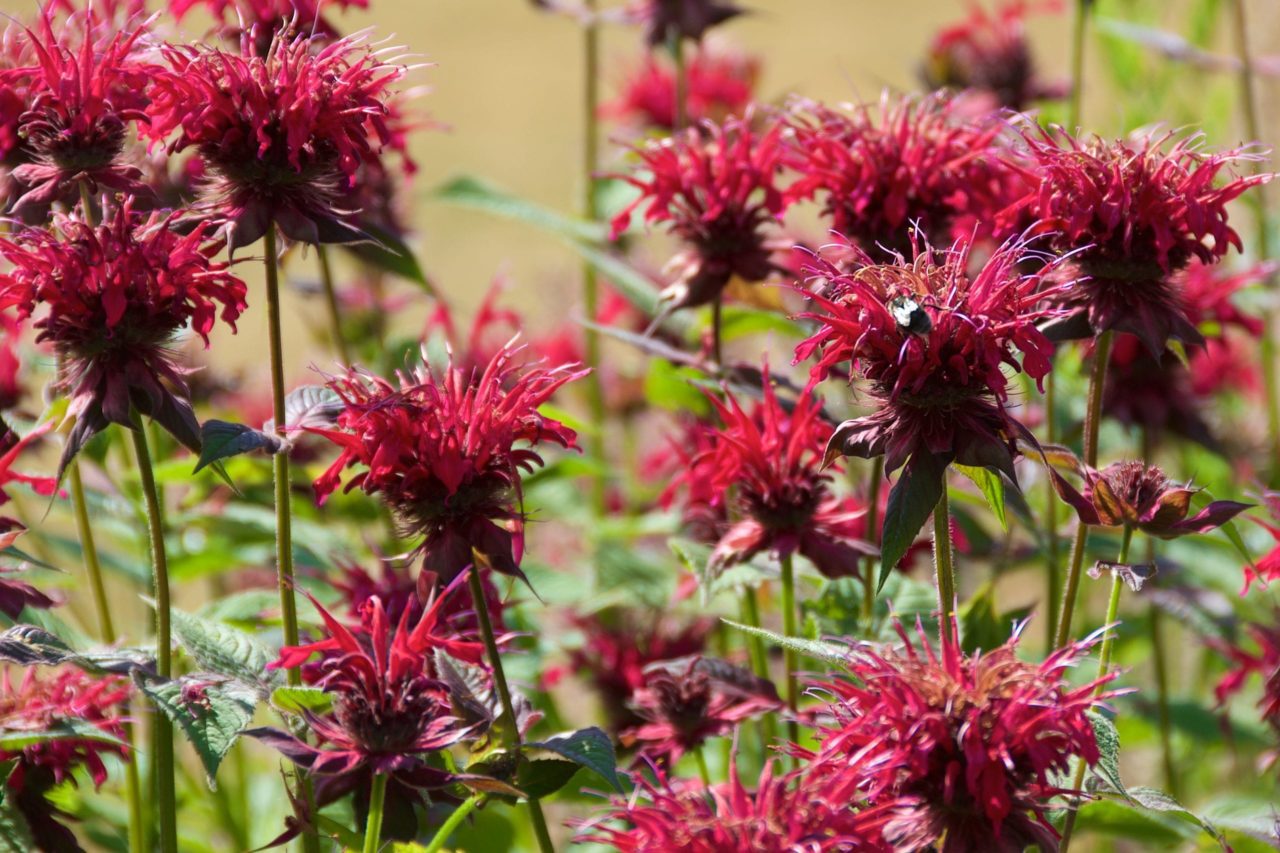If the term wasn’t already nabbed, I’d refer to the gardening du jour as ‘Guerilla’ gardening. We’re seemingly fighting with the elements to keep the garden alive. It’s all extremes. Cold wave to mega heat wave in just a matter of weeks. Beasty from the East and Storm Emma brought rampaging winds, snowfall that squashed carefully curated seed head displays, and plant murdering frosts. Come spring we were splashing around for weeks in the wettest March & April for a decade with temperatures shy of 10 degrees Celsius. And now incredibly, the ground is drier than the Argentinian Pampas, with temperatures rivalling the Med, and we’ve all got better tans than native Sicilians. Skeptics may disagree, but I’m sure we’re in for more extreme weather in future and we’ll simply have to learn to work with it.
The marketing spin doctors have had a busy year, the poor blighters. In spring, it was all ‘create a rain garden‘ and this summer they were singing the praises of ‘drought tolerant plants‘ and the joy of ‘dry gardens‘. The best advice though, is to forget what you’re growing in it for a minute, and instead start looking at your soil.
Empower your Terroir
Whether it’s endlessly raining, or dry as a bone out there, the only true weapon we have is the condition of our soil. Healthy soil can work extreme miracles. Friable, humus rich soil can not only ensure optimum absorption during times of heavy rainfall, but also retain moisture during periods of drought. In addition, protect plants from both scorching temperatures as well as heavy frosts.
Think of your soil as basically the nutrient larder for your garden. To access those nutrients, plants need both water and oxygen. Oxygen is needed for plants to respire, and take up water and nutrients. No oxygen, no water. No water, no nourishment. If waterlogged during periods of heavy rain, soil pores are saturated and plant roots can suffocate. In periods of drought, soil cavities only fill with air leading to the plant wilting, shrivelling and dying. Obviously, the weather is beyond our reach but a healthy soil is not. The recipe for healthy soil is simple and you’ve all heard it before. The is miracle cure is good garden compost. Adding compost will create a healthy, friable soil containing good levels of humus, ensure effective plant nutrient uptake and crucially, improved ability to absorb water and oxygen.
There is no doubt that the areas of our garden that have enjoyed incremental aggregation of good garden compost fared best. Drainage has improved, whilst maintaining and improving the water holding capacity of the soil. The (clay) soil is more workable, even during prolonged periods of rain. Soil porosity has improved, so I know that air and water can move freely through the soil. Plant roots penetrate deeply into the soil and we’re finally starting to see less soil compaction, which was horrendous when we started. During the drought, critical moisture was noticeably retained longer, reducing the need for watering which was a true blessing during the drought. Plants that needed water, recovered quicker and retained the water longer. Furthermore, year on year, fewer plants are lost to frosts as plant roots are better protected.
By adding garden compost you are also providing the optimal munchies for the soil dwelling creatures we so rely on. Worms, microbes, nematodes bacteria, fungi break down organic material into humus, improve soil porosity, stir up soil levels, aerate soil and contribute to the creation of a healthy soil structure full of pores. Providing good room and board for the soil’s micro life (and all things wildlife above ground) is always high on my agenda.
Feed me, feed me, feed me…
Unfortunately, you do need quite a lot of garden compost to cook up the optimum soil structure. I like to work in generous spadefuls, as well as piling on a thick 5 cm mulch layer. The compost bins are hard at work, but even with 5 largish bins, we never quite have enough. I therefore focus on specific areas, and move around the garden to ensure generous coverage.
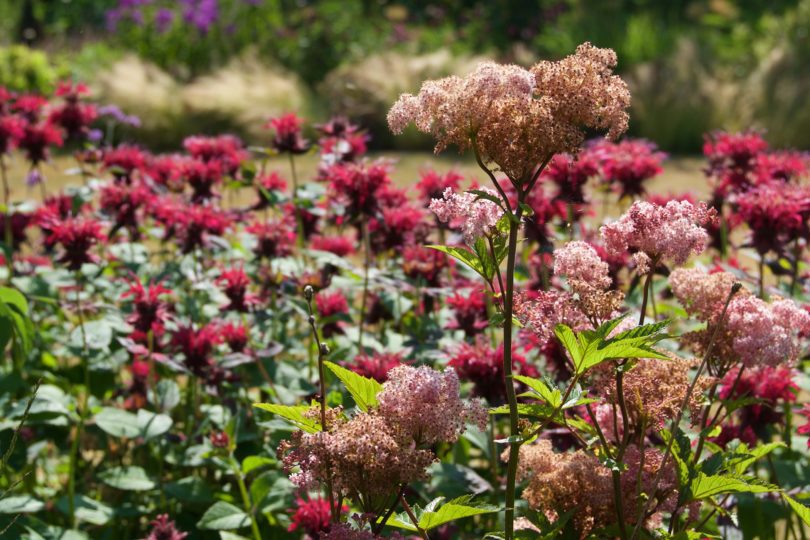
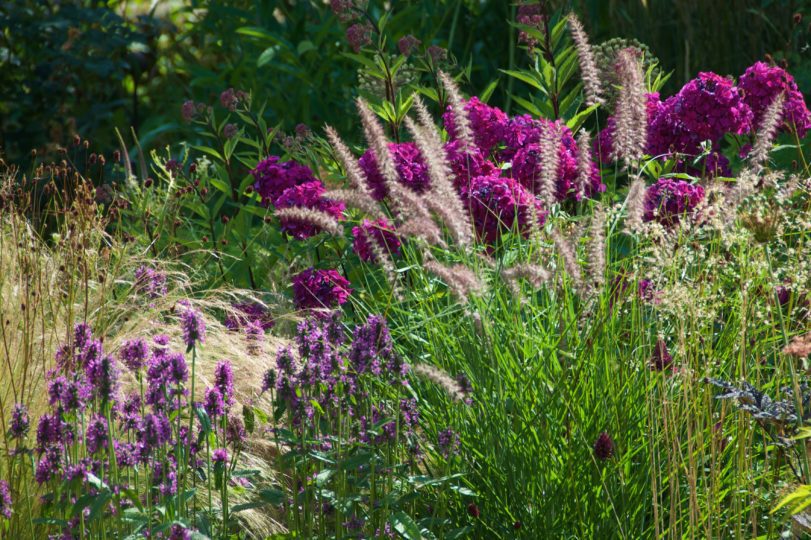
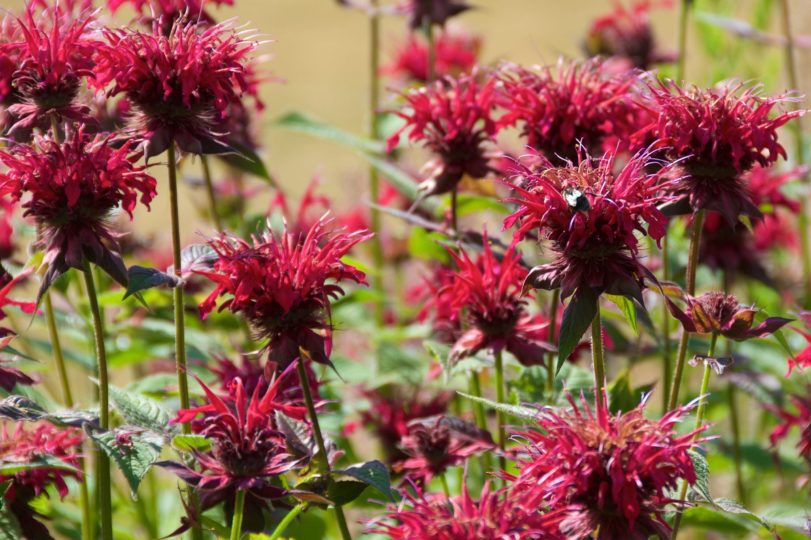
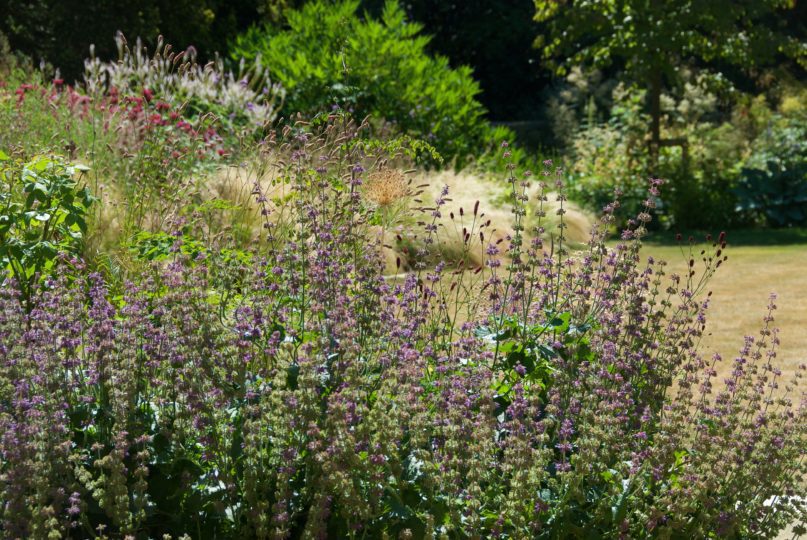
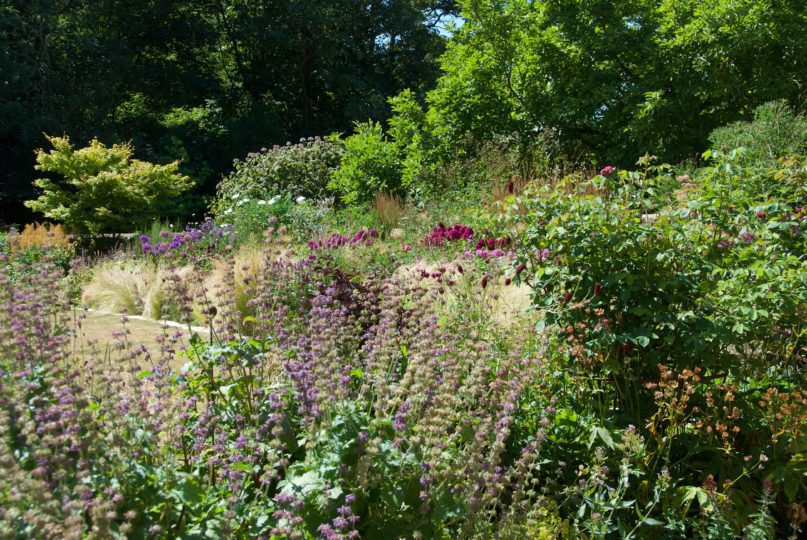

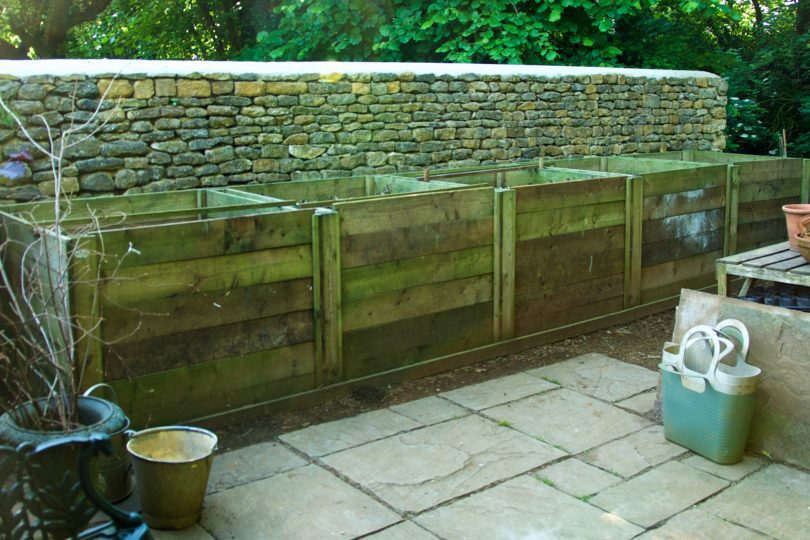

Pretty much everything in the garden is happily piled onto the compost bins, apart from perennial weeds. We mow, cut, chop and dead head until the cows come home in the aid of keeping those bins active. The kitchen too is hard at work to contribute. Fruit and veggies that provide both sustenance for us as well as the compost bins are much favoured. That counts for what we grow on the allotment as well as the produce we buy. Think of your compost bins as hungry labradors looking for treats. Anything that provides peels, tops, foliage, or extras for the compost bin are high on my shopping list. Lazy ‘prepared veg’ from the shops are a definite no no, as someone else’s compost bins are enjoying those freebies. Watermelons are my current summer favourite; good levels of peelage to be had there.
Fussy puppies
For plants that turn their petals up at my homemade compost, we provide leaf mould. The new herb garden, with all the lavenders, sages, santolina, thymes etc., are just not suited to our rich compost. Sun loving, Mediterranean type plants perform better in well drained, low nutrient soils. Leaf mould is low on fast-acting plant nutrients and contributes to a healthy soil ecosystem, by bolstering the soil with humus. Drainage is still good enough to keep herb roots out of anything wet, but water is also retained better. Similar result as the compost, but a tailored (guerilla gardening) solution for this part of the garden, which despite their sunny origins have not fared the heatwave without problems.
Hit Hot bins
For a fervent composter, it is always disappointing to see cooked food, leftovers or any non home compost suitable produce, donated to the council. To take advantage of this bounty, we have installed a snazzy Hot Bin.
Reaching temperatures of 40-60 degrees celsius, my new compost pressure cooker makes mince meat out of the toughest of weeds, cooked kitchen scraps and even left over take away chicken curry. A rarity admittedly, but it was all in the name of road testing this composting puppy.
Hermetically sealed, there is no odour from the bins and therefore no attraction to vermin. It takes approximately 3 months for the contents to turn into compost, and the result is nice friable material. Granted, it doesn’t have that woody natural smell of garden compost but it’s not bad. It all depends on what you put in of course and that curry couldn’t have helped. If you’re adding a lot of food, make sure you add enough carbon material to absorb this more ‘soupy’ of composting ingredients. Adding weeds, the odd bit of grass clippings, chipped twigs/branches, shredded paper, does the trick.
Once filled, try – and this is tricky I grant you – to resist opening the bin to have a peek. If in doubt, remember the wise words of my guru and mentor, Mr Weber of Weber BBQ’s, whom has a similar distaste to lifting of BBQ lids; ‘If you’re lookin’, it ain’t cookin”…..
It’s early days, but the Hotbin is proving an incredible asset to our compost production. A full bin load, produces about 5-6 generous wheelbarrows full, which is very welcome indeed. It’s particularly satisfying knowing that the friable matter that comes out of its underbelly is generated from materials we would otherwise have thrown away. That’s a win for reducing landfill waste, but especially so for my garden.
Someone fetch that Dutch boy to plug the dyke….
Compost works miracles, but we still need water. The drought has certainly hammered home that we need to be more respectful and efficient with our water usage. Unfortunately on that note, I put my water conquering, Dutch compatriots to shame. Having pretty much always relied on the habitual cold, wet Oxfordshire weather to keep the garden watered, there was little need for cunning water exploits. Though, with eight consecutive weeks without a drop, or even morning dew to rely on, we are forced to face the fact that this is no longer a given. Add to that the threat of hosepipe bans, cash ringing water meters and the ever increasing ‘guilt’ that comes with hosepipe watering, things have to change.
I won’t lie, we have at times had little choice and had to bring out to the hosepipe to water the garden. The heat and drought take their toll. Hosepipes though, go through roughly 550 litres of drinking water per hour so there have to be alternative sources. Having long depleted rain water sources and without the prospect of rain, the focus is therefore on water usage and recycling water.
Grey Smarts
Grey water is an overlooked marvel. Brilliant during the drought as an alternative source, but one that should be common place all year round, drought or no drought. Too much of this bounty needlessly disappears down the plughole. With grey water, I’m of course referring to the relatively ‘clean’ waste water from baths, sinks, and other kitchen appliances. A drop of soap, be it dishwashing liquid or shower gel won’t harm plants at all. Grey water actually contains nutrients, which can actually be beneficial to plants. Even young plants or seedlings don’t mind vintage aqua, so fear not. I do save the ‘dirtier soapy water’ for tougher plants, such as trees and shrubs. Furthermore, anything containing bleach, (dishwasher soap) salt, tough cleaning products are a definite no no. If in doubt, go eco for all things soap which is better still. Grey water is more alkaline, so avoid for use on acid loving plants, such as camellias and ferns and I wouldn’t use it on direct edibles such as lettuce, spinach etc..
Recycling water is easy and once you start it’s quickly routine. There isn’t a sink in the house that hasn’t got a bowl in it. Showers and bath tubs are all adorned with buckets. Washing up water, left over drips of coffee, tea (neat that is), even that stray ice cube is collected. The realisation of how much water we ‘throw’ away every day is staggering, and a lesson worth learning first hand. Every time you rinse your coffee cup, or wash your hands that’s on average a litre gone. Consider how many times you wash your hands,… that’s quite a few litres.
Ideally, we all have our plumbing altered to harvest and filter grey water for re-use. Systems such as these are unfortunately not common place, require substantial research and probably a considerable initial outlay. Definitely worth considering when upgrading/replacing old systems though. Ours is up for an upgrade in the not so distant future, and we will certainly look into the possibilities – especially for re-use in the garden. We are also investigating the possibility of installing a large rain water tank underneath the drive to collect rainwater from the roof. In the meantime, however we are conserving what we can though conventional methods.
Old wives watering tale or truth?
Be it on the telly, or in mags and the papers, we’re told to water deeply, once or twice per week to encourage plants to send roots down as far as possible to reach it. Yet, there is another school of thought that advises to water plants & trees more frequently, with less, as plants will eventually require significantly less water.
I believe the theory originated from self-taught horticulturist Robert Kourik, whom has followers applying this watering technique successfully in arid parts of Australia. Cunning water irrigators therefore, which is why this theory intrigues me.
According to Kourik, we can save water by watering more frequently, with lesser amounts, every day – especially during times of drought. The reasoning is that plants and trees are unable to absorb large amounts of water immediately. About a third, is lost to the deeper levels of subsoil which are unused by the garden. Hose pipe watering is partial this. Through daily watering, with small amounts, the top 5-10 cm of soil will act like a moisture blanket through capillary action. Plant roots, bacteria and fungi, trap the moisture in this soil level, where roots naturally seek their nutrients. Training plants to dig their roots down, costs them not just in terms of the energy required to do so, but may also steer them out of the nutrient rich levels of the top soil level. Followers of this theory report, improved garden health and growth levels relative to the deep watering method.
The caveat though is that you must have healthy, water retentive soil across the entire garden. To ensure effective capillary action, the surrounding subsoil must have good levels of humus to provide plants limitless access to water and nutrients. If the existing soil is poor, and holds little organic matter in the 5-10cm, Kourik advises that organic matter should be applied.
So, if you’re not composting, build/install/buy some compost bins. If all else fails, put down that plant at the garden centre, and buy a bag of compost instead….
